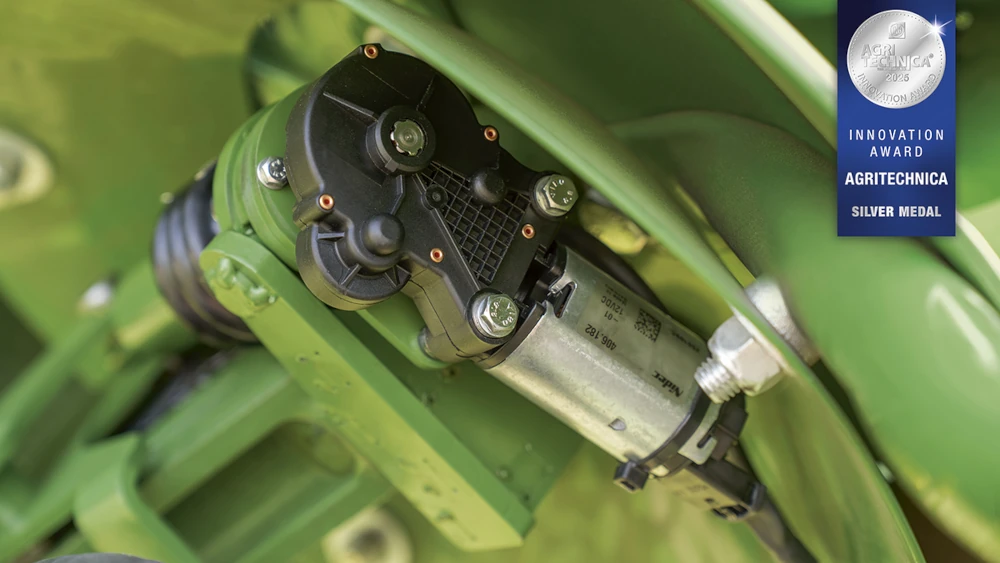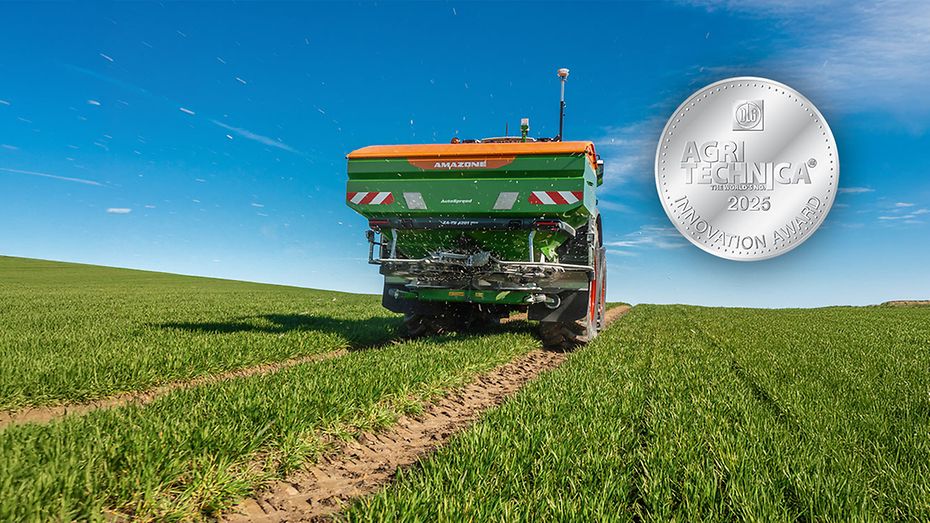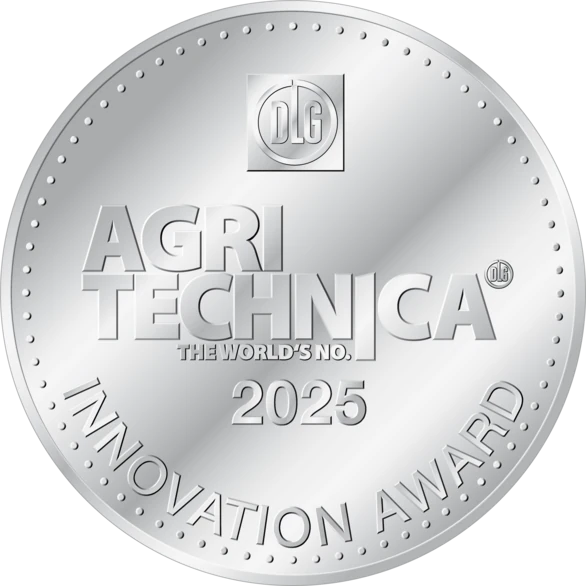Deutz-Fahr, Krone and Amazone have all Received the Silver AGRITECHNICA Innovation Award.

DEUTZ-FAHR has been awarded the Silver Medal of the Agritechnica Innovation Award 2025 for its innovative TAGS technology. The winning innovation marks a major step forward in agricultural safety, precision, and automation.
Tailor-Made for Farming
Unlike conventional automotive ADAS (Advanced Driver Assistance Systems), which are tailored to smooth roads, uniform traffic, and fixed infrastructure, TAGS is specifically developed for agricultural use – supporting both road transport and field operation. Whether navigating narrow rural paths, varying terrain, or mixed-use field environments, it goes beyond standard sensors and software. This is where DEUTZ-FAHR sets itself apart.
One System. Two Levels. Infinite Safety.
The TAGS technology is built around the DEUTZ-FAHR concept of ‘tractor as a sensor’. This means the tractor becomes a smart, connected hub that continuously gathers and shares data from the field. By integrating sensors, connectivity, and intelligence directly into the machine, DEUTZ-FAHR transforms the tractor into a central node of the digital farming ecosystem, enabling more precise, efficient, and safer operations.The DEUTZ-FAHR Tractor Assisted Guidance System is based on agricultural-rated, digital high-resolution cameras with High Dynamic Range (HDR) capability, fully integrated into the tractor’s design. These cameras deliver fast, high-quality images and are water-repellent, shock-resistant, and built to withstand the demanding conditions of fieldwork. The system is scalable and supports up to three monocameras.For advanced functionality, the stereo camera units offer real-time 3D scene mapping. DEUTZ-FAHR’s system measures actual depth, shape, and object movement—enabling the tractor to truly understand its surroundings. This is essential for safely and efficiently navigating challenging terrain, including uneven ground, unmarked paths, and crop-covered fields. To offer customised performance across different farming profiles, the system consists in two levels: a Standard and an Advanced version.
Standard Level
Lane Assist – Keeps the tractor safely in lane, with visual and acoustic alerts
Human Detection – Warns about people in the tractor’s danger zones
Crossroad Assist – Expands the operator’s view to a 190° stitched front panorama
Overtake Indicator – Alerts when vehicles approach from behind
Advanced Level
Off-Road Lane Assist – Identifies navigable terrain, even without lane markings
3D Obstacle Detection – Recognizes static and dynamic objects
Adaptive Cruise Control (ACC) – Maintains safe distance on road and field
Traffic Sign Recognition – AI-based classification with automatic alerts
Powered by a high-performance AI-ECU, ready for future autonomous functions
Engineered for Tomorrow
Combining stereo vision, real-time AI, and a highly scalable system architecture, TAGS is the result of DEUTZ-FAHR Research and Development, with the support of Stereolabs (France), a specialist in real-time spatial AI, and Politecnico di Milano, one of Europe’s leading engineering universities. The Silver Medal confirms DEUTZ-FAHR’s leading role in Smart Farming Solutions and underlines its focus on developing technology that performs in real farming conditions—not just on paper.

KRONE receives silver AGRITECHNICA Innovation Award for KRONE OptiSet

Silver for a world first: Maschinenfabrik Bernard Krone GmbH & Co. KG has been honoured with the prestigious AGRITECHNICA Innovation Award for the development of the KRONE OptiSet system on the Vendro rotary tedder. The jury honoured a practical solution that enables the spreading angle to be adjusted centrally, synchronously and steplessly from the cabin for the first time.
With the KRONE OptiSet, KRONE has developed pioneering technology for forage recovery. The spreading angle of all rotors can be conveniently adapted from the driver’s seat at the touch of a button – quickly, ergonomically and efficiently. This previously had to be completed manually on each individual rotor with a great deal of effort, but can now be completed centrally in seconds. This allows farmers and contractors to optimise their machines to changing harvesting conditions at any time.
The benefits are evident: More frequent spreading angle adjustments ensure a higher forage quality, reduce rolling losses and help to make the best possible use of short harvest periods. At the same time, the system increases operator comfort and opens up prospects for autonomous use in the future.
“Receiving the award at AGRITECHNICA is a great honour and confirms our claim to provide farmers and contractors with practical innovations,” explains Jan Horstmann, Managing Director of Maschinenfabrik Bernard Krone GmbH & Co. KG.
The Vendro series offers working widths from 4.70 m to 13.40 m and up to twelve rotors. It impresses with numerous innovative details such as OptiTurn tines, maintenance-free OctoLink eight-finger couplings, a compact V-frame, as well as precise and robust guide wheels for maximum efficiency and forage quality in the field.

A new era of precision: the self-adjusting fertiliser spreader

With the new ZA-TS 01, AMAZONE is offering a technology which revolutionises fertiliser spreading. After years of development and successful trials in the field on over 100,000 hectares, the unique AutoSpread feature sets new standards in precision and automation. An autonomous solution for optimum fertiliser distribution is being implemented for the first time. AutoSpread monitors the actual spread pattern of the fertiliser and automatically adjusts the settings to achieve optimum distribution. Combined with the intelligent online connection to the AMAZONE Spreader Application Cente, the actual spread pattern is permanently validated, meaning that the operator no longer has to make any settings. This solution is unique and offers a particularly high degree of innovation.
The central challenge of fertilisation: having the correct setting
The AutoSpread system has been intensively tested in practice on over 100,000 hectares during the series development.
The central challenge of precise fertilisation has always been as to whether the centrifugal broadcaster is set correctly. The global fertiliser market is characterised by a growing product diversity and an increasing heterogeneity in fertiliser types and fertiliser batches, which further increases the complexity for farmers. Incorrect spreader settings can lead to uneven distribution of the fertiliser, which in turn results in reduced yields and loss of quality. This not only results in economic losses but also impairs sustainability and efficiency in agriculture.
Each fertiliser has individual properties which affect the settings. For example, the shape and position of SectionControl depend on the specific throwing distance.
AMAZONE has always been known for its innovative developments in the field of fertilisation. For example, Argus, an award-winning system for monitoring the direction of throw, was presented for the first time back in 2007. Argus therefore set a milestone in the optimisation of mineral fertiliser distribution and made it possible to compensate for the influence of changing fertiliser qualities for the first time. However, precise pre-adjustment to the respective fertiliser was also necessary here. This was the first step towards automation. But Dr Heinz Dreyer (1932 – 2023), AMAZONE’s third generation Managing Director, already had a bigger vision back then: the self-adjusting fertiliser spreader. AMAZONE is now offering the solution in the shape of the new ZA-TS 01 AutoSpread.
Precise and permanent – perfect lateral distribution in seconds
The ZA-TS 01 is the guarantee to outstanding precision. For the first time, AutoSpread measures the actual flight characteristics of the fertiliser and adjusts the spreader automatically. The view behind in the field that has been missing so far is now a thing of the past.
The ZA-TS AutoSpread is a self-adjusting fertiliser spreader. The combined measurement of the throwing direction and, for the first time, the throwing distance turn it into a mobile spreading hall. An intelligent online connection to the AMAZONE Spreader Application Center (SAC) permanently validates the actual spread pattern.
Existing systems such as ArgusTwin already enable the direction of throw to be measured, but the actual throwing distance of the fertiliser remains unknown. If an incorrect throwing direction is set as the target variable, this will result in incorrect application with a loss of yield and quality.
Permanent optimisation of all systems by AutoSpread – automatic determination of the actual switch points for Section Control
The throwing distance of the fertiliser can only be determined under stationary laboratory conditions – up to now. However, this is essential for all spreading situations in the field. An incorrect throwing distance not only leads to a loss of accuracy in the normal spread pattern but also to incorrect switch-on and switch-off points in Section Control.
Thanks to the additional AutoSpread sensors, it is now possible for the first time to determine not only the throwing direction but also the throwing distance and consequently the actual spread pattern in the field. This turns the ZA-TS 01 AutoSpread into a mobile spreading hall. Whilst the innovative solutions for the various individual situations such as HeadlandControl, WindControl (according to Prof. Dr. Karl Wild of the University of Applied Sciences, Dresden) or Section Control used to be individual solutions, they are now optimally integrated via AutoSpread for the first time. For example, in the case of Section Control, AutoSpread automatically determines the actual switch-on and switch-off points or adjusts the control process for the current fertiliser via the WindControl wind sensor. In combination with the new border spreading system, the distribution is also optimised in the field boundary area. With AutoSpread, all systems are more accurate than ever before and all areas of the field are fertilised in the best way possible .
Reliable and intelligent – reliability of application thanks to its digital twin
AutoSpread consists of the sensors for spread pattern monitoring and the AmaConnect Unit for networking with the AmaConnect cloud-based data platform
AutoSpread not only ensures maximum precision but also reliability of the spreading process as well as the intelligent monitoring of lateral distribution. Whilst it was previously only possible to test the spreading quality at a selective point via manual test kits in the field, AutoSpread enables continuous validation of the actual spread pattern. Thanks to the online connection to the AMAZONE spreading hall (SAC) via the AmaConnect Unit, the fertiliser’s digital twin is automatically transferred to the spreader in the field. The actual collected data is now compared with the known spread patterns of its digital twin using an AI-supported algorithm and is permanently validated in real time. Incorrect fertiliser settings are reliably detected and the spread pattern is perfectly adjusted. Thanks to the intelligent connection, this is also possible offline in the event of a network failure, so reception problems in the field are not a problem.
With the help of this innovative spread pattern monitoring, AutoSpread can also reliably detect worn or defective spreading vanes before the spread pattern deviates. The quality of the lateral distribution is always in view via a display on the terminal. If anomalies occur or the measured spread pattern does not match the reference of its digital twin, AutoSpread specifically prompts you to check with the EasyCheck digital test kit and ensures that any errors are quickly rectified where necessary. The system therefore provides the spreading process with a high degree of reliability through continuous validation of the autonomously set parameters. The use of spreader testing to check the distribution is significantly reduced and unnecessary spreader tests are a thing of the past. This saves time and ensures maximum convenience.

